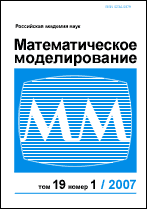|
This article is cited in 3 scientific papers (total in 3 papers)
Solution problems of oil recovery with waterflood using polymer-disperse systems on multiprocessor computer systems
A. I. Nikiforov, R. V. Sadovnikov
Institute of Mechanics and Engineering, Kazan Science Center, RAS
Abstract:
The paper presents results of a numerical simulation of the impact of a polymer-dispersed systems on oil reservoirs in order to increase the flow resistance of flooded areas and to involve in active development a non-moving or slow moving oil reserves. Mathematical model of this process was built on the basis of the known laws of conservation of mass and momentum. Capillary model of a porous medium was used for construction of a closure relations that allows us to describe the formation of polymer-disperse components and their influence on the porous medium. The complexity of solving the problem of impact of polymer-dispersed systems on the process of displacement of oil by water from porous medium is related to the three-dimensionality, non-stationarity processes of filtration, as well as the need to calculate the fields of polymer concentration, pressure and saturation fields, structural changes in porosity and permeability at each time step and at each point in space. All these factors require a significant computer time and resources. The paper presents a parallel implementation of the algorithm for multiprocessor computer system using the MPI library. Calculations on a real field have shown efficiency of the algorithm.
Keywords:
flooding, polymer-dispersed system, porosity, permeability, parallel computing, multiprocessing system.
Received: 12.03.2015
Citation:
A. I. Nikiforov, R. V. Sadovnikov, “Solution problems of oil recovery with waterflood using polymer-disperse systems on multiprocessor computer systems”, Matem. Mod., 28:8 (2016), 112–126; Math. Models Comput. Simul., 9:2 (2017), 221–231
Linking options:
https://www.mathnet.ru/eng/mm3761 https://www.mathnet.ru/eng/mm/v28/i8/p112
|

| Statistics & downloads: |
| Abstract page: | 354 | | Full-text PDF : | 258 | | References: | 49 | | First page: | 16 |
|




 Contact us:
Contact us: Terms of Use
Terms of Use
 Registration to the website
Registration to the website Logotypes
Logotypes








 Citation in format
Citation in format 
